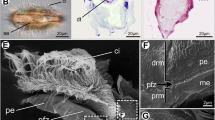Abstract
Adult specimens of Terebratulina retusa and Crania anomala have one pair of metanephridia. Each metanephridium is composed of a ciliated nephridial funnel (nephrostome) and an outleading nephridial canal, thus, these organs are open ducts connecting the metacoel of the animal with the outer medium. In both species, the inner side of a nephrostome is lined by a columnar monociliated epithelium which contacts the coelothel within one of the two ileoparietal bands. The coelothel contains basal filaments (in C. anomala these are definite myofilaments). The canal epithelium also consists of monociliated columnar cells which differ from the nephrostome epithelial cells in size and some cell components. Within the nephropore, the canal epithelium makes contact with the so-called inner mantle epithelium which lines the mantle cavity. The nephrostome epithelial cells and the canal epithelial cells never contain any contractile filaments. There are always continuous transitions between these different epithelia and distinct borders cannot be observed. The present results, especially in comparison to Phoronida, do not contradict the hypothesis of a coelothelially derived nephridial funnel and an ectodermal nephridial duct in Brachiopoda. But with regard to the differences between Phoronida and Brachiopoda (larval protonephridia and podocytes in the adults are unknown in Brachiopoda), further investigations have to be done to test the hypothesis of such heterogeneously assembled metanephridia.
Similar content being viewed by others
References
Ashworth JH (1915) On larvae of Lingula and Pelagodiscus (Discinisca).. Trans Soc Edin 51:45–69
Ax P (1989) Basic phylogenetic systematization of the Metazoa. In: Fernholm B, Bremer K, Jörnvall H (eds) The hierarchy of life. Elsevier Science Publishers, Amsterdam, pp 229–245
Bartolomaeus T (1989) Ultrastructure and relationship between protonephridia and metanephridia in Phoronis muelleri (Phoronida). Zoomorphology 109:113–122
Bartolomaeus T, Ax P (1992) Protonephridia and metanephridiatheir relation within the bilateria. Z Zool Syst Evolutionsforsch 30:21–45
Blochmann F (1892) Untersuchungen über den Bau der Brachiopoden I: Die Anatomie von Crania anomala O.F.M.. Gustav Fischer, Jena, pp 1–65
Blochmann F (1990) Untersuchungen über den Bau der Brachiopoden II: Die Anatomie von Discinisca lamellosa, Broderip und Lingula anatina, Bruguière. Gustav Fischer, Jena, pp 69–124
Caldwell WH (1883) Preliminary note on the structure, development and affinities of Phoronis. Proc Soc Lond 34:371–383
Carlson SJ (1991) Phylogenetic relationships among brachiopod higher taxa. In: McKinnon DI, Lee DE, Campbell JD (eds) Brachiopoda through time. Balkema, Rotterdam, pp 3–10
Chuang SH (1990) Brachiopoda. In: Adiyodi KG, Adiyodi RG (eds) Reproductive biology of invertebrates IV (B): fertilization, development and parental care. Oxford and IBH Publishing, New Delhi Bombay Calcutta, pp 211–254
Cuvier G (1802) Mémoire sur l'animal de la Lingule (Lingula anatina Lam.). Ann Mus Nat Hist Natur 1(1)
Emig CC (1977) Embryology of the Phoronida. Am Zool 17:21–337
Emig CC (1984) On the origin of the Lophophorata. Z Zool Syst Evolutions forsch 22:91–94
Goodrich ES (1895) On the coelom, genital ducts and nephridia. Q J Microsc Sci 37:477–510
Goodrich ES (1945) The study of nephridia and genital ducts since 1895. QJ Microsc Sci 86:113–395
Hancock A (1858) On the organization of the Brachiopoda. Phil Trans R Soc 148:791–869
Heller M (1932) Über die exkretorische Tätigkeit der Brachiopoden. Z Morphol Ökol Tiere 24:238–258
Huxley TH (1854) Contributions to the Anatomy of the Brachiopoda. Proc Soc Lond 7:106–117
Hyman LH (1959) The invertebrates, vol 5: smaller coelomate groups. McGraw-Hill, New York London Toronto, 783 pp
James MA, Ansell AD, Collins MJ, Curry GB, Peck LS, Rhodes MC (1992) Biology of living Brachiopoda. Adv Mar Biol 28:175–387
Kümmel G (1967) Die Podocyten. Zool Beitr N F 13:245–263
Morse ES (1872) On the oviducts and embryology of Terebratulina. Am J Sci Arts Ser 3 Art 32:262–263
Owen R (1835) On the anatomy of the Brachiopoda of Cuvier, and more especially of the genera Terebratula and Orbicula. Trans Zool Soc Lond 1:145–164
Percival E (1944) A contribution to the life-history of the brachiopod Terebratella inconspicua Sowerby. Trans R Soc New Zealand 74:1–23
Plenk H (1913) Die Entwicklung von Cistella (Argiope) neapolitana. Ein Beitrag zur Entwicklungsgeschichte der Brachiopoden (1. Mitteilung). Arb Zool Inst Wien 20:93–108
Popov LL, Bassett MG, Holmer LE, Laurie J (1993), Phylogenetic analysis of higher taxa of Brachiopoda. Lethaia 26:1–5
Rowell AJ (1960) Some early stages in the development of the brachiopod Crania anomala (O.F. Müller). Ann Mag Nat Hist 13:35–52
Rowell AJ (1982) The monophyletic origin of the Brachiopoda. Lethaia 15:299–307
Ruppert EE, Balser EJ (1986) Nephridia in the larvae of hemichordates and echinoderms. Biol Bull 171:188–196
Ruppert EE, Smith PR (1988) The functional organization of filtration nephridia. Biol Rev 63:231–258
Schaeffer C (1926) Untersuchungen zur vergleichenden Anatomie und Histologie der Brachiopodengattung Lingula. Acta Zool 7:329–402
Selys-Longchamps M de (1904) Développement postembryonaire et affinités des Phoronis. Mem Sci Acad Belg 1:1–150
Vogt C (1845) Anatomie der Lingula anatina. N Denkschr allg Schweiz Ges ges Naturw 7:1–18
Williams A, Rowell AJ (1965) Brachiopod anatomy. In: Moore RC (ed) Treatise on invertebrate paleontology part H: Brachiopoda. University of Kansas Press, pp 6–57
Yatsu N (1902) On the development of Lingula anatina. J Coll Sci Tokyo 17:1–112
Author information
Authors and Affiliations
Rights and permissions
About this article
Cite this article
Lüter, C. Ultrastructure of the metanephridia of Terebratulina retusa and Crania anomala (Brachiopoda). Zoomorphology 115, 99–107 (1995). https://doi.org/10.1007/BF00403258
Accepted:
Issue Date:
DOI: https://doi.org/10.1007/BF00403258




